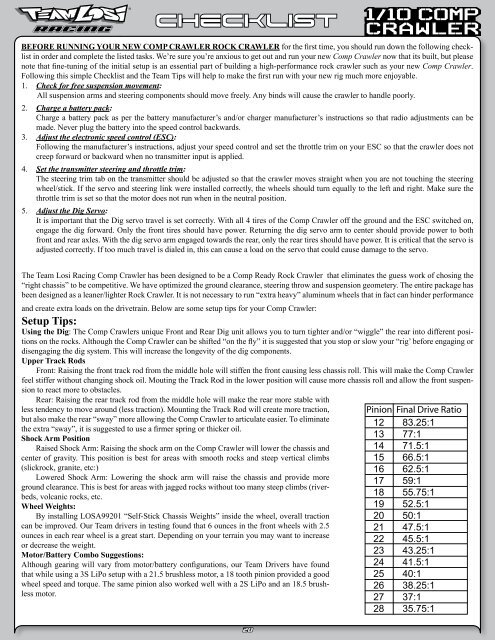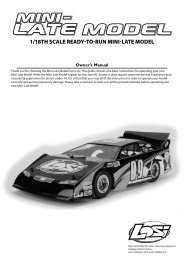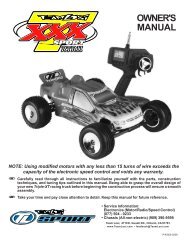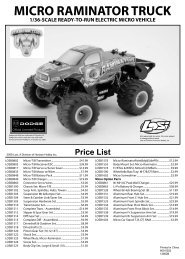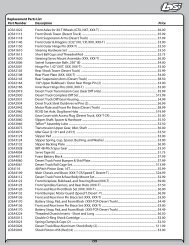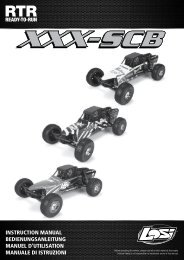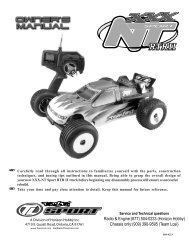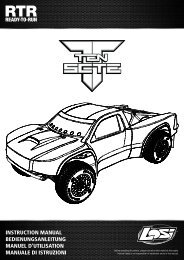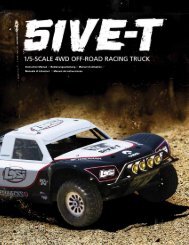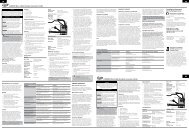1/10 Comp Crawler Race Roller Manual - Team Losi Racing
1/10 Comp Crawler Race Roller Manual - Team Losi Racing
1/10 Comp Crawler Race Roller Manual - Team Losi Racing
Create successful ePaper yourself
Turn your PDF publications into a flip-book with our unique Google optimized e-Paper software.
ChecklIST<br />
BEFORE RUNNING YOUR NEW COMP CRAWLER ROCK CRAWLER for the first time, you should run down the following checklist<br />
in order and complete the listed tasks. We’re sure you’re anxious to get out and run your new <strong>Comp</strong> <strong>Crawler</strong> now that its built, but please<br />
note that fine-tuning of the initial setup is an essential part of building a high-performance rock crawler such as your new <strong>Comp</strong> <strong>Crawler</strong>.<br />
Following this simple Checklist and the <strong>Team</strong> Tips will help to make the first run with your new rig much more enjoyable.<br />
1. Check for free suspension movement:<br />
All suspension arms and steering components should move freely. Any binds will cause the crawler to handle poorly.<br />
2. Charge a battery pack:<br />
Charge a battery pack as per the battery manufacturer’s and/or charger manufacturer’s instructions so that radio adjustments can be<br />
made. Never plug the battery into the speed control backwards.<br />
3. Adjust the electronic speed control (ESC):<br />
Following the manufacturer’s instructions, adjust your speed control and set the throttle trim on your ESC so that the crawler does not<br />
creep forward or backward when no transmitter input is applied.<br />
4. Set the transmitter steering and throttle trim:<br />
The steering trim tab on the transmitter should be adjusted so that the crawler moves straight when you are not touching the steering<br />
wheel/stick. If the servo and steering link were installed correctly, the wheels should turn equally to the left and right. Make sure the<br />
throttle trim is set so that the motor does not run when in the neutral position.<br />
5. Adjust the Dig Servo:<br />
It is important that the Dig servo travel is set correctly. With all 4 tires of the <strong>Comp</strong> <strong>Crawler</strong> off the ground and the ESC switched on,<br />
engage the dig forward. Only the front tires should have power. Returning the dig servo arm to center should provide power to both<br />
front and rear axles. With the dig servo arm engaged towards the rear, only the rear tires should have power. It is critical that the servo is<br />
adjusted correctly. If too much travel is dialed in, this can cause a load on the servo that could cause damage to the servo.<br />
The <strong>Team</strong> <strong>Losi</strong> <strong>Racing</strong> <strong>Comp</strong> <strong>Crawler</strong> has been designed to be a <strong>Comp</strong> Ready Rock <strong>Crawler</strong> that eliminates the guess work of chosing the<br />
“right chassis” to be competitive. We have optimized the ground clearance, steering throw and suspension geometery. The entire package has<br />
been designed as a leaner/lighter Rock <strong>Crawler</strong>. It is not necessary to run “extra heavy” aluminum wheels that in fact can hinder performance<br />
and create extra loads on the drivetrain. Below are some setup tips for your <strong>Comp</strong> <strong>Crawler</strong>:<br />
Setup Tips:<br />
Using the Dig: The <strong>Comp</strong> <strong>Crawler</strong>s unique Front and Rear Dig unit allows you to turn tighter and/or “wiggle” the rear into different positions<br />
on the rocks. Although the <strong>Comp</strong> <strong>Crawler</strong> can be shifted “on the fly” it is suggested that you stop or slow your “rig’ before engaging or<br />
disengaging the dig system. This will increase the longevity of the dig components.<br />
Upper Track Rods<br />
Front: Raising the front track rod from the middle hole will stiffen the front causing less chassis roll. This will make the <strong>Comp</strong> <strong>Crawler</strong><br />
feel stiffer without changing shock oil. Mouting the Track Rod in the lower position will cause more chassis roll and allow the front suspension<br />
to react more to obstacles.<br />
Rear: Raising the rear track rod from the middle hole will make the rear more stable with<br />
less tendency to move around (less traction). Mounting the Track Rod will create more traction,<br />
but also make the rear “sway” more allowing the <strong>Comp</strong> <strong>Crawler</strong> to articulate easier. To eliminate<br />
the extra “sway”, it is suggested to use a firmer spring or thicker oil.<br />
Shock Arm Position<br />
Raised Shock Arm: Raising the shock arm on the <strong>Comp</strong> <strong>Crawler</strong> will lower the chassis and<br />
center of gravity. This position is best for areas with smooth rocks and steep vertical climbs<br />
(slickrock, granite, etc:)<br />
Lowered Shock Arm: Lowering the shock arm will raise the chassis and provide more<br />
ground clearance. This is best for areas with jagged rocks without too many steep climbs (riverbeds,<br />
volcanic rocks, etc.<br />
Wheel Weights:<br />
By installing LOSA99201 “Self-Stick Chassis Weights” inside the wheel, overall traction<br />
can be improved. Our <strong>Team</strong> drivers in testing found that 6 ounces in the front wheels with 2.5<br />
ounces in each rear wheel is a great start. Depending on your terrain you may want to increase<br />
or decrease the weight.<br />
Motor/Battery Combo Suggestions:<br />
Although gearing will vary from motor/battery configurations, our <strong>Team</strong> Drivers have found<br />
that while using a 3S LiPo setup with a 21.5 brushless motor, a 18 tooth pinion provided a good<br />
wheel speed and torque. The same pinion also worked well with a 2S LiPo and an 18.5 brushless<br />
motor.<br />
20


